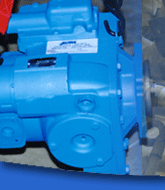

For more details, please contact your account specialist.
Position–Controlled Power Actuator (Westinghouse)
Control Pac is short for Position-Controlled Power Actuator. The position–controlled power actuator provides the power to open and close the inlet steam valves and the extraction steam valves to maintain required turbine speed and extraction steam pressure. You know them as your Governor, Throttle, Reheat-Stops and Intercept Valve Actuators. The control pac includes the servovalve, dump valve, hydraulic cylinder, check valves, isolation valve, 10 micron filter, solenoid valve and other components attached to the control block.
It is well known that operating efficiency of precision parts can be severely reduced and failure can occur by dirt and fluid deterioration. Periodically during turbine operation, or during routine inspection of the valve chest, inspect the wipers in the top of the actuator for oil leakage. A wet wiper surface is normal. However, if the oil actually drips from the cylinder, the actuator wipers and seals must be replaced at the first opportunity. Check the EHC fluid for varnishing and contamination. The best way to check your EHC fluid for contamination is visual inspection of the servovalve strainer, which should be done by ServoCon ALPHA. Your fluid should be checked on a continuing basis for contamination to insure a cleanliness level conducive to servovalve control.
The other items to check are the total leakage of the control pac as a system, the contamination assessment for the varnishing and how that, along with other contamination on the low flow or blind side of the cylinder, is affecting system performance. If your servovalve strainers are plugged or varnished, the cylinders they are controlling need to be disassembled cleaned and tested with the servovalves as a unit to insure that proper control will be maintained when the unit is brought back on line. Sometimes normal wear but more often side loading on the cylinder has occurred and the cylinders piston rods are worn or scored and need to be replaced. New seals must operate free of burr or they will rapidly deteriorate from stroking when the system is brought back on line.
Another area of concern that is typically overlooked in control pacs are the orifices that provide pressure drops that control the hydraulic components they operate. When contamination is present, these orifices are the next to be affected because their sizes, in some cases, go as low as .015 inches in diameter. The orifices must be removed, cleaned, gauged, reinstalled and tested to be sure the associated components are functioning properly.
The culprit, varnishing, has many sources and is difficult to eliminate completely in hydraulic control systems. The sources are the presence of mineral oil over long periods, high temperatures, hydrocarbons used for rinse, foaming bubble formation, water presence at system pressure, metal salts, worn piston rings inside of cylinders and servovalve BSA leakage above minimum requirements which will cause your auxiliary pumps to start working to make up for the pressure loss thus heating the oil.
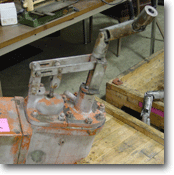 |
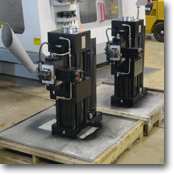 |
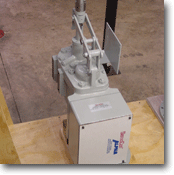 |
EHC System Cleaning
When a system is contaminated it is difficult to remove all of the contamination
even when the complete system is done. There is a higher chance of failure
when components are done one or two at a time. This is primarily because
of the possibility of re-contaminating the repaired components and assemblies
with contamination residing in the unrepaired portions of the system.
Optimally it is best to clean and calibrate the whole system at one time.
Remember to be assured of removing the medium and heavy varnishing and oxidation from within a control pac and other servocontrol components, they must be disassembled, inspected machined and polished. FLUSHING ALONE WILL NOT REMOVE ALL VARNISHING. To learn more about your system please continue to read.
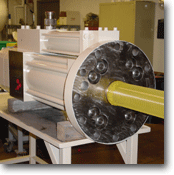 |
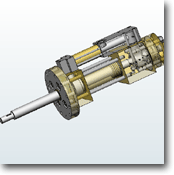 |
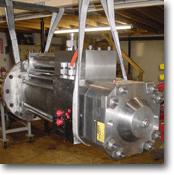 |
[ < back to top ]
Governor Valve Actuator Control Pac
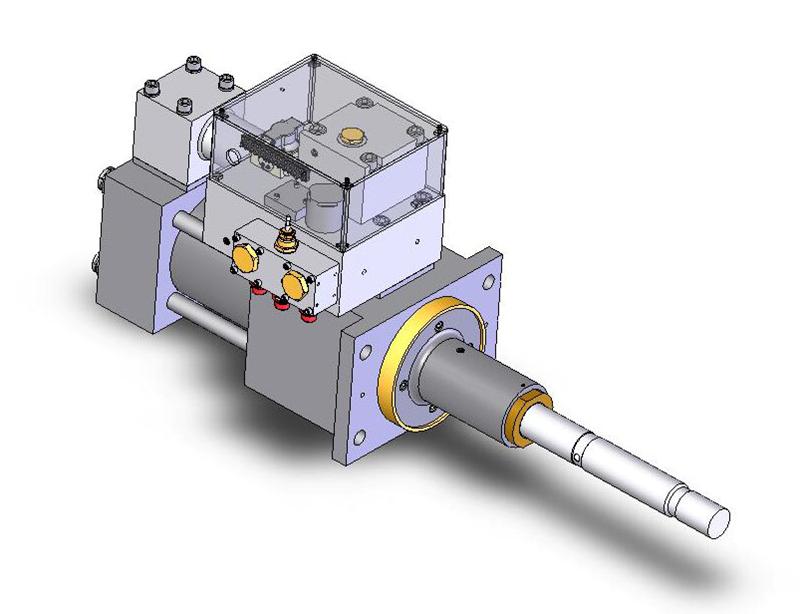
The actuator is provided to operate the governor valve. It is mounted on the governor valve spring housing, which in turn is secured to the top of the steam chest over each governor valve. A coupling to the governor valve stem directly connects the actuator shaft. Upward movement of the operating piston opens the valve and downward movement closes the valve. The actuator is single acting and provides only the force to open the valve.
The principal components of the actuator (Control Pac) are hydraulic cylinder, block, servovalve, dump valve, LVDT, shut-off valve, check valves and filter. The block provides a means for mounting and connecting all of the components together. It also has a terminal strip for electrical hookup and fittings for hydraulic connections.
Operation
The flow of high-pressure fluid through an isolation valve and a ten-micron
metal mesh filter to the actuator is controlled by a servovalve. The position
control and LVDT position feedback signals are summed at the servo-amplifier
resulting in a position error signal. The servo-amplifier positions the
servovalve in response to this error signal to accurately position the
actuator and steam valve.
All high-pressure fluid passes through the ten-micron filter element. This insures clean fluid at all times for the operation of the servovalve. The filter element is a metal mesh design and should be replaced every three months. It may be cleaned and reused when the ServoCon ALPHA stainless steel filter line is used.
Servovalve
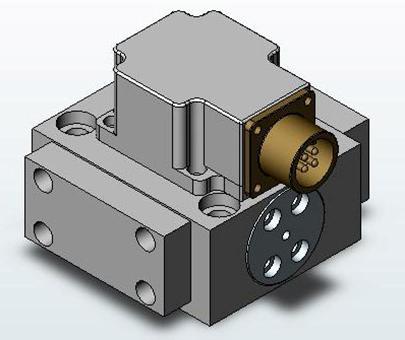
The servovalve is a pilot-operated, closed center, four-way sliding spool valve in which the output flow varies with the error signal. The servovalve directs high-pressure fluid into one end of the hydraulic cylinder to open the steam valve and releases operating fluid from the hydraulic cylinder to allow the steam valve to close. The servovalve is mechanically biased to assure fail-safe operation upon power failure.
The servovalve consists of a polarized electrical torque motor and two stages of hydraulic power amplification with mechanical feedback. The first stage consists of a dual nozzle and single flapper. The flapper is attached to the mid-point of the armature and passes between the two nozzle tips and the flapper. The pressure controlled by the flapper and nozzle is fed to end areas of the second-stage spool. The second-stage spool is a four-way sliding spool design in which output flow from the valve, at a constant pressure drop, is proportional to the spool displacement from null. A cantilever feedback spring engages a slot in the center of the spool. In the null position, the flapper imposes an equal restriction to flow through both nozzles and no differential pressure exists to cause spool displacement. Upon application of a signal to the torque motor, the armature and flapper are displaced toward one nozzle or the other, reacting a pressure differential across the spool resulting in spool displacement. The spool will continue to move until the counteracting force transmitted through the feedback spring equals the force developed by the torque motor. At this point, the flapper has returned to neutral and the pressure differential across the spool is zero. The spool remains in its new position until another differential current is applied.
Servovalves should be kept from the elements and stored in a dry place in a sealed wrapper. They should be cleaned and calibrated at least every two years to keep the valve lubricated and to minimize the hardening of the o-rings. We recommend operational servovalves be removed from turbine and sent to ServoCon ALPHA for cleaning and calibration once a year.
Actuator Dump Valve
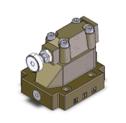
The dump valve maintains the high pressure operating fluid beneath the
hydraulic cylinder operating position. When this valve functions, the
high pressure operating fluid beneath the operating piston is released
to drain. This allows the force of the springs to close the valve.
The dump valve can be activated by means of the emergency trip system or by the auxiliary governor trip to provide quick closing independent of the electrical system. When the dump valve is activated it releases all high pressure operating fluid to drain. Heavy springs on the steam valve assembly provide the force for quick closing. It is recommended that ServoCon ALPHA clean and calibrate your dump valve when Control Pac is being refurbished.
This valve is connected to the actuator. In normal operation the pressure setting adjustment is adjusted for maximum pressure. The emergency trip fluid pressure is equal to the high-pressure fluid pressure and holds the spool on its seat with the help of spool spring. The actuator operating fluid cannot spill to drain. Dump valves should be cleaned and calibrated annually.
Isolation Valve
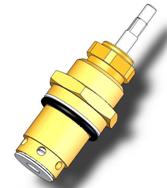
A shut-off valve is provided to cut off the supply of the high-pressure
fluid to the actuator. This permits maintenance on the actuator, such
as replacement
of the solenoid or dump valve, without shutting down the turbine.
Check Valve

A check valve is used in the fluid drain line to prevent drain fluid from
the pressurized drain header from flowing back during maintenance on the
actuator. A check valve in the emergency trip fluid line permits the closing
of any actuator, whether for test or maintenance, without affecting the
position of other actuators.
Westinghouse Interceptor Actuator Control Pac
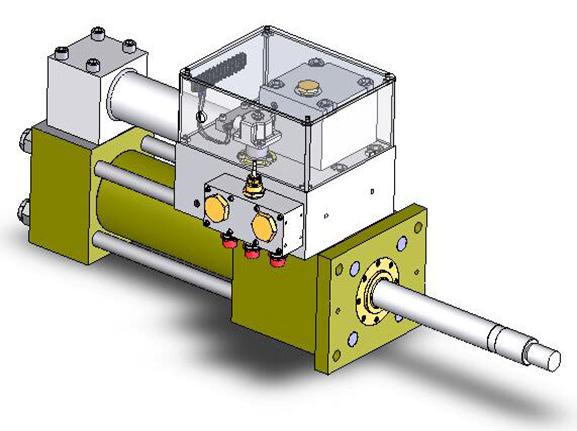
This actuator is provided to operate the interceptor valve and it is connected
directly to the valve stem. The interceptor valve operates in a full open
or full closed position. It is single acting and provides the force for
opening the valve and the compressed spring recoil provides the force
to close the valve.
The principal components of the actuator (Control Pac) are the hydraulic cylinder, block, solenoid valve, dump valve, shut-off valve and check valves. The block provides a means for mounting and connecting all of the components together and is also a terminal for all electrical and hydraulic connections.
Operation
The high pressure operating fluid is admitted through an orifice to the
hydraulic cylinder-operating piston. As the fluid pressure increases beneath
the piston, it overcomes the force of the closing springs and opens the
steam valve.
The dump valve maintains the high-pressure operating fluid beneath the
hydraulic operating piston. When this valve functions, the high pressure
operating fluid beneath the operating piston is released to drain and
the force of the springs closes the steam valve.
The dump valve can be activated electrically by means of the solenoid-operated
valve or by the auxiliary governor trip to provide quick closing and can
also be activated by the emergency trip system independent of the electrical
system. When the dump valve is activated it releases all high pressure
operating fluid to drain. Heavy springs on the steam valve assembly provide
the force for quick closing.
Isolation Valve

A shutoff valve is provided to cut off the supply of high-pressure fluid
to the actuator. This permits maintenance on the actuator such as replacement
of the solenoid valve or dump valve without shutting down the turbine.
Actuator Dump Valve

In normal operation the emergency trip fluid pressure is equal to the
high pressure operating fluid pressure and holds the valve on its seat
with the help of the spring. When the control governing valve emergency
trip fluid is released, the dump valve releases the operating fluid to
drain.
Check Valve

A check valve is used in the fluid drain line to prevent drain fluid from
the pressurized drain header from flowing back during maintenance on the
actuator. A check valve in the emergency trip fluid line permits the closing
of any actuator, whether for test or maintenance, without affecting the
position of the other actuators.
Solenoid-Operated Valve
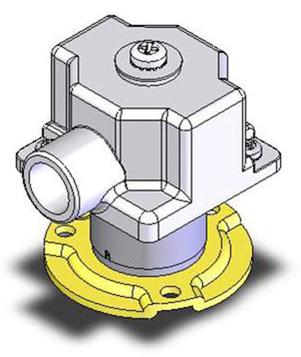
This valve is used for remote closing of the valve for periodic test of
the valve stem freedom. It releases the control-governing valve emergency
trip fluid for the particular valve thereby causing the dump valve to
function. Solenoid-operated valves should be cleaned and calibrated annually.
Refurbishment
ServoCon ALPHA recommends refurbishment of the Interceptor Valve Actuator
Control Pac every three years. Here are reasons to refurbish your Interceptor
Valve Actuator:
- Actuator sluggish
- Actuator will not open
[ < back to top ]
Reheat Stop Valve Actuator Control Pac
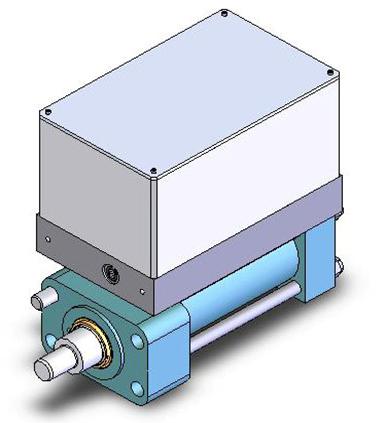
The actuator operates the reheat stop valve. It is connected directly to the reheat stop valve stem. This valve operates in a full open or full closed position. The actuator is single acting and provides the force for opening the valve and closing springs provide the force to close the valve.
The components of the actuator (control pac) are hydraulic cylinder, block, solenoid valve, relief valve, shut off valve, and check valve. The block provides a means for mounting and connecting all the components together and is also a terminal for all electrical and hydraulic connections.
Operation
An orifice controls the flow of high-pressure fluid through an
isolation valve to the actuator. The high-pressure fluid is admitted through
an orifice into the hydraulic cylinder which opens the steam valve. The
dump valve releases the operating fluid from the hydraulic cylinder to
allow the steam valve to close.
A pilot operated relief valve is used as a dump valve. The pilot is actuated by the emergency trip header to provide the quick closing independent of the electrical system. When the dump valve is activated it releases all high-pressure operating fluid to drain. The drain is also connected to the upper end of the hydraulic cylinder and accommodates the released fluid so that the drain line is not over loaded. Heavy springs on the valve assembly provide the force for quick closing.
Isolation Valve

A shutoff valve is provided to cut off the supply of high-pressure
fluid to the actuator. This permits maintenance on the actuator such as
replacement of the solenoid valve or dump valve without shutting down
the turbine.
Check Valve

A check valve is used in the fluid drain line to prevent drain
fluid from the pressurized drain header from flowing back during maintenance
on the actuator. A check valve in the emergency trip fluid line permits
the closing of any actuator, whether for test or maintenance, without
affecting the position of the other actuators.
Dump Valve

This valve is connected to the actuator. In normal operation the pressure
setting adjustment is adjusted for maximum pressure. The emergency trip
fluid pressure is equal to the high-pressure fluid pressure and holds
the spool on its seat with the help of spool spring. The actuator operating
fluid cannot spill to drain. Dump valves should be cleaned and calibrated
annually.
Solenoid-Operated Valve

This valve is used for remote closing of the valve for periodic
test of the valve stem freedom. It releases the control-governing valve
emergency trip fluid for the particular valve thereby causing the dump
valve to function. Solenoid-operated valves should be cleaned and calibrated
annually.
Refurbishment
ServoCon ALPHA recommends refurbishment of the Interceptor Valve
Actuator Control Pac every three years. Here are reasons to refurbish
your Interceptor Valve Actuator Control Pacs immediately:
- Actuator sluggish
- Actuator will not open
[ < back to top ]
Throttle Valve Actuator Control Pac
The actuator is provided to operate the throttle valve. It is mounted on the throttle valve spring housing, which in turn is secured to the top of the steam chest over each governor valve. A coupling to the throttle valve stem directly connects the actuator shaft. Upward movement of the operating piston opens the valve and downward movement closes the valve. The actuator is single acting and provides only the force to open the valve.
Operation
The flow of high-pressure fluid through an isolation valve and
a ten-micron metal mesh filter to the actuator is controlled by a servovalve.
The position control and LVDT position feedback signals are summed at
the servo-amplifier resulting in a position error signal. The servo-amplifier
positions the servovalve in response to this error signal to accurately
position the actuator and steam valve.
The principal components of the actuator (Control Pac) are hydraulic cylinder, block, servovalve, dump valve, LVDT, shut-off valve, check valves and filter. The block provides a means for mounting and connecting all of the components together and is also a terminal for all electrical and hydraulic connections.
Metal Mesh Filter
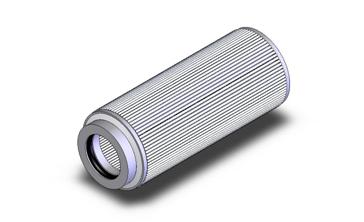
All high-pressure fluid passes through the ten-micron filter element.
This insures clean fluid at all times for the operation of the servovalve.
The filter element is a metal mesh design and should be replaced every three
months. It may be cleaned and reused if ServoCon ALPHA does the procedure.
Servovalve

The servovalve is pilot-operated, closed center, four-way sliding
spool valve in which the output flow varies with the error signal. The
servovalve admits high-pressure operation fluid the hydraulic cylinder
to open the steam valve and releases operating fluid from the hydraulic
cylinder to allow the steam valve to close. The servovalve is mechanically
biased to assure fail-safe operation for of electrical signal.
Servovalves should be kept from the elements and stored in a dry place in a sealed wrapper. They should be cleaned and calibrated at the very least every 2 years to keep the valve lubricated and to minimize the hardening of the o-rings. Operational servovalves should be removed from turbine and sent to ServoCon ALPHA for clean and calibration once a year.
Dump Valve

This valve is connected to the actuator. In normal operation the pressure
setting adjustment is adjusted for maximum pressure. The emergency trip
fluid pressure is equal to the high-pressure fluid pressure and holds
the spool on its seat with the help of spool spring. The actuator operating
fluid cannot spill to drain.
It is recommended to order spare dump valves under ALPHA p/n B0440534/B900081. Dump valves should be cleaned and calibrated annually by ServoCon ALPHA.
Isolation Valve

A shut-off valve is provided to cut of the supply of the high-pressure
fluid the actuator. This permits maintenance on the actuator, such as
replacement
of the solenoid or dump valve, without shutting down the turbine.
Check Valve

A check valve is used in the fluid drain line to prevent drain
fluid from the pressurized drain header from flowing back during maintenance
on the actuator. A check valve in the emergency trip fluid line permits
the closing of any actuator, whether for test or maintenance, without
affecting the position of other actuators.
Refurbishment
ServoCon ALPHA recommends refurbishment of the Governor Valve
Actuator Control Pac every three years. Here are reasons to refurbish
your Governor Valve Actuator Control Pacs immediately:
- EHC servovalve strainer contaminated
- Actuator sluggish
- Actuator will not open
- EHC servovalve stuck
- Valve stem stuck.
Spring and Spring Housing
The spring and spring housing should be sent with control pac.
ServoCon ALPHA will disassemble, clean and calibrate, visually inspect,
weld, machine, paint and test to specification. The spring seat will be
tested and the spring housing sub assembly will be measured and tested
with special tools to make sure there is no wear.
[ < back to top ]
Advantages of using ServoCon ALPHA
- We have detailed ALPHA drawings and specifications of the components as well as the system drawings showing orifice positions and sizes
- Three-dimensional assembled E-drawings
- Proper test fixtures, flow stands factory trained technicians, and the facilities to repair and test all components of the Control Pac
- We have an engineering department with the latest Parametric Modeling design and instrumentation to develop and produce all needed production and quality assurance documentation. Our capability includes designing the parts and producing the prototypes in the computer, producing the G-code to manufacture the parts in the milling and turning environment automatically to specification.
- The work is done in our state of the art facility
- We test and repair every component on the Control Pac individually and as a unit
- We can accommodate any repair turnaround you require
- When we return your control pacs, they will be tested and ready for your final flush. ServoCon ALPHA minimizes the possibility of startup failures
What we do (a quote is available upon request)
- Receive your Control Pacs in our lab
- Each Control Pac is visually inspected and our receiving inspector notes outward condition
- All components are marked for identification so that the same components stay with the correct control Pac
- Any contamination found will be documented for your review and our customer records. Digital pictures are available
- All components are removed and disassembled individually and are extensively cleaned internally as well as externally
- Inspect all parts including critical dimension checks of the dump valve, seats, seals, barrels, piston rods, glands, check valves, and subassemblies to ensure that wear/damage results are with in specifications.
- Seals are replaced on all components. Pricing for these will be sent to you on a price approval sheet prior to doing any work
- All components are assembled and tested to specifications. The Control Pac is then tested at system pressure with sinusoidal input for stroking to break in seals. Internal leakages are checked and individual components are evaluated for minimum leakage requirements.
- When there are no signs of external or internal leakages, the units are prepared for safe shipment back to customer
- Control Pacs are painted using three-part epoxy paint
- Detailed inspection reports are prepared
[ < back to top ]
Below are the spare parts that you should have in case of failure. To place an order simply call ServoCon ALPHA at our toll free number with the cross reference numbers below.
| Westinghouse P/N | Description | Order ALPHA P/N |
| 735-506-G001 | Governor Valve Actuator | L0703273 |
| 624C673001 | Governor Valve Actuator | L0703274 |
| 624C673005 | Throttle Valve Actuator | |
| 390A924002 | Solenoid Valve | B0120002 |
| 390A891001 | 10 Micron Stainless Steel Filter | S0060002 |
| 459B369001 | Isolation Valve (Shutoff Valve) | B0060007 |
| 459B369002 | Check Valve | |
| 390A892001 | Pilot Operated Relief Valve, Manifold | B9000081, B0440534 |
| 390A893001 | EHC Servovalve | L7613601 |
| 390A951001 | Flushing Valve | Z0012800 |
| Flushing Block | Z0011802 |
Pick-Up and Delivery
Ask your account specialist
for delivery rates and availability of pickup.
Click here to download the Control Pac PDF.
[ < back to top ]
| Home | Markets | Product Solutions | Corporate | Customer Support | Downloads | What's New | Contact Us |